-
Publish Your Research/Review Articles in our High Quality Journal for just USD $99*+Taxes( *T&C Apply)
Offer Ends On
Fabian Renger* and Robert Niemuth
Corresponding Author: Fabian Renger, Medical Care Centre Dr Renger / Dr Becker Heidenheim, Germany.
Received: June 27, 2023 ; Revised: July 14, 2023 ; Accepted: July 17, 2023 ; Available Online: August 18, 2023
Citation: Renger F & Niemuth R. (2023) Study of Job Satisfaction in Pharmacists and Competing Professional Fields on the Basis of the KAFA Method. J Nurs Midwifery Res, 2(1): 1-7.
Copyrights: ©2023 Renger F & Niemuth R. This is an open-access article distributed under the terms of the Creative Commons Attribution License, which permits unrestricted use, distribution, and reproduction in any medium, provided the original author and source are credited.
Views & Citations
Likes & Shares
Pharmacies in Germany are failing to attract sufficient personnel. This trend poses a risk for healthcare, jeopardising the supply of medicines to the population. Although the number of pharmacies has fallen while the number of graduates has remained the same, pharmacies are failing to recruit young pharmacists, leading to problems with succession planning and closures. This research report compares the findings relating to job satisfaction in pharmacists in public pharmacies and pharmacists in other professional sectors. The KAFA questionnaire (a short questionnaire for assessing general and facet-specific job satisfaction) was used to determine how job satisfaction is perceived and rated. The results show that job satisfaction among existing personnel in pharmacies is high, but a young successor generation is not willing to enter the pharmacist profession. Another approach would be to relax the regulations for becoming registered to practice as a pharmacist, which would allow people with related professional qualifications to work in pharmacies. This could include graduates in chemistry, biology and combined subjects involving both areas, as well as medical graduates.
Keywords: German pharmacy market, Personnel management, Job satisfaction, Public health, Supply of medicines
INTRODUCTION
The German pharmacies market has undergone a continuous drop in the number of brick-and-mortar outlets since 2010. While 21,441 public pharmacies were recorded in 2010, by 2021 the number had dropped to 18,461 [1]. In 2022, another 393 business premises were lost, with only 18,068 pharmacies being recorded in the statistics of the ABDA (Federal Union of German Associations of Pharmacists) in early 2023 [2]. In the context of national economies relying on functional healthcare systems, pharmacies are of systemic importance in their role as dispensaries for patients and healthcare-oriented establishments and as a source of accompanying advice and monitoring of medicines. One of the reasons for the decline is thought to be that pharmacy proprietors are closing their businesses without any replacement because of a lack of business success, a lack of personnel or failure to find new pharmacists who are willing to take over. Existing tasks could be offset by an increase in the number of new branches, but pharmacists have limited options here as they are restricted to a maximum of three branches and are bound regionally by the district border principle. Nevertheless, since permission was granted by the legislator in 2004, the number of branch pharmacies rose from 1,228 (2005) to 4,743 in 2021 [1]. In 2022, however, it was found that the first 30 branches had by then closed, as they were not able to recruit any personnel for the branch or could no longer be operated profitably [2]. In terms of personnel, the largest problem is that a pharmacy can only be run by a registered pharmacist, and they must be present in person. If this is not the case, the pharmacy is obliged to close either temporarily or permanently.
METHODOLOGY
The study concentrates on the expert profession of pharmacist in order to investigate a profession of high relevance for society. The reason why pharmacists have such high relevance is that they constitute an elementary part of healthcare provision. The legally regulated professional group is assigned the role of providing medicines and is obliged to provide a knowledge-intensive service which involves giving advice relating to medicines and assessing and maintaining their quality. Pharmacists also make an important contribution to the creation and monitoring of medicinal treatment approaches and compliance with treatment regimes in collaboration with doctors [3]. As a large percentage of these professional pharmacists are now active in other professional sectors, the research approach also needs to be applied to a control group in order to identify the job satisfaction situation in other professions in which pharmacists work. Differences in the findings could serve to provide insight regarding what other professional sectors offer for the group of pharmacists which is better, worse or different compared with working at a pharmacy. In order to develop a research design for this topic, hypotheses were created for an empirical investigation based on numeric data which will then be confirmed by the research design. These hypotheses can be applied to both cohorts.
On this basis, the following alternative hypotheses can be posited:
For an empirical survey using quantitative methods to determine job satisfaction in pharmacists, key elements were taken from the parameters of the Job Diagnostic Survey of Hackman/Oldham [4] and implemented in the form of the KAFA as a valid survey instrument [5]. The total sample size is n=748. The two cohorts are divided into 384 pharmacy pharmacists and 364 pharmacists in other professional fields outside of pharmacies. It was taken into account that pharmacists are a category of employees which differ in some areas from average employees in terms of their high quality as specialists. The remaining areas are based in terms of the statements on the key research features which were defined by Hackman and Oldham and which determine job satisfaction (skill variety, task identity, task significance, autonomy and feedback). This results in the following portfolio of statements which the subjects are asked to select from in the form of a Likert scale assessment. In addition, markers are used that specify which statements have a negative connotation. At the end of the comments, the statement is categorised in the division matrix in accordance with Hackman and Oldham. In order to test the hypotheses, a regression analysis was performed which explains the dependent variable on the basis of independent variables 1 to n [6]. The regression analysis is an analysis of the causality of causal analysis topics [7]. The concentration is based on the attitude of subjects in a negative or positive direction in regression to the average [8]. In this regard, it is necessary to formulate target variables and independent variables [9]. A distinction is made between the dependent or target variables (DVs) and independent variables (IVs) that influence them. The number of independent variables is in theory unlimited, but at least one IV is required (bivariate regression). If there is more than one IV, this is referred to as multivariate regression [6].
The following formula describes multiple regression with two predictors mathematically:

represents the estimated DV values which are explained by the IVs. An unexplained random portion is also possible:

refers to residuals or random, unexplained disturbance variables.
Mathematically, the regression analysis is based on the method of least squares. This involves minimising the following target value:

This target value is the function of the unknown regression parameters which are determined when the function is minimised. The formula for the regression parameters can be deduced manually, but all standard statistics programs [9] provide complete estimates [6]. In each model, an ANOVA (analysis of variance) or an F-test is performed. These also serve to test model accuracy. The values of the F-statistics and the significance are listed and described. If the F-statistics are significant, then the null hypothesis that all regression coefficients are zero and that the model is thus invalid can be discarded [10].
RESULTS (Table 1)
For the purposes of inferential statistical analysis, the ordinal scaled variable is considered quasi-metric.
Hypothesis 1:
The following Analysis of Variance - (ANOVA) table shows that the F-test is significant:
F(6.725)=61.511, p < 0.01. This means that the model is significant overall.
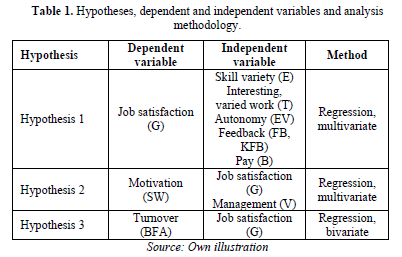
Table 2 shows the results of the individual partial hypotheses of hypothesis 1.
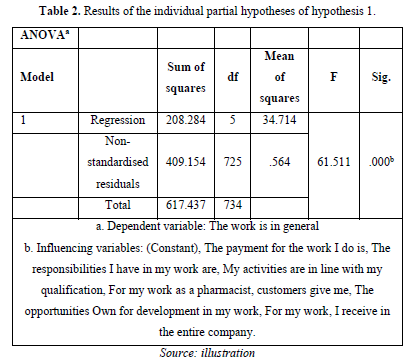
Table 2 shows the following results: Skill variety has a positive significant influence on job satisfaction: b=0.125, p < 0.01.
Interesting, varied work has no significant influence on job satisfaction: b=0.040, p=0.095 > 0.05. However, if the significance were raised from 5% (classic) to 10%, which is permitted under some circumstances, this result would also be significant. Autonomy has a positive significant influence on job satisfaction: b=0.103, p < 0.01.
Feedback has a positive significant influence on job satisfaction: b=0.247 and b=0.145, p < 0.01 in both cases.
Pay (B) has a positive significant influence on job satisfaction: b=0.178, p < 0.01.
Table 3 shows that the corrected determination coefficient R2=0.332 means that job satisfaction can be explained statistically by the key factors at a rate of 33%.
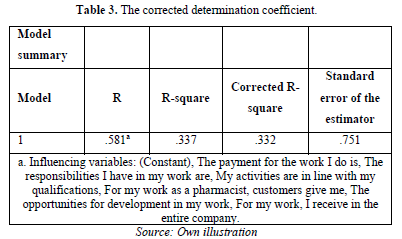
In summary, it can be concluded that hypothesis 1 has been confirmed. All partial hypotheses in the formulations are valid. Determining the differences between the public pharmacist and the non-public pharmacist hypotheses is of interest. In technical terms, this is accomplished by integrating an additional dichotomous predictor in the regression which precisely maps the distribution between the sectors. Table 3 shows, however, that this predictor has no significant influence (p = 0.921 > 0.05). There are therefore no significant differences between the two groups regarding hypothesis 1. In summary, it can be concluded that hypothesis 1 has been confirmed. All partial hypotheses in the formulations from section 3 are valid. Being a public pharmacist or a non-public pharmacist does not play a role.
Hypothesis 2
The ANOVA table shows that the F-test is significant: F(2.747)=24.012, p < 0.01. This means that the model is significant overall. The additional Table 4 shows the results of the individual partial hypotheses of hypothesis 2.
Table 4 shows the following results:
Lastly, Table 5 shows that the corrected determination coefficient R2 = 0.058 indicates that motivation can be explained statistically by job satisfaction and management at a rate of 6%.
As was the case for hypothesis 1, the differences between the public pharmacist and the non-public pharmacist hypotheses are analysed. Table 6 shows that this parameter plays a significant role in hypothesis 2: p=0.034 < 0.05. As the coefficient (b=-0,184) of the regression is negative, it can be stated that the dependent variable motivation is lower for the non-public pharmacists.
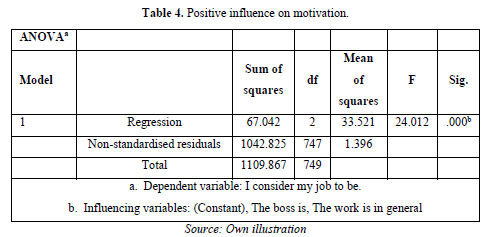

In summary, it can be concluded that hypothesis 2 has been confirmed with all partial hypotheses as stated in section 3. The public pharmacists display higher values for motivation than the non-public pharmacists. The results of the analysis for hypothesis 3 are given below.

The ANOVA table shows that the F-test is significant: F(1.748)=94.177, p < 0.01. This means that the model is significant overall. Table 7 shows the results of the individual partial hypotheses of hypothesis 3.

Table 7 shows the following results:
Lastly, Table 8 shows that the corrected determination coefficient R2=0.112 means that turnover can be explained statistically, or in other words reduced, by job satisfaction at a rate of 11%.
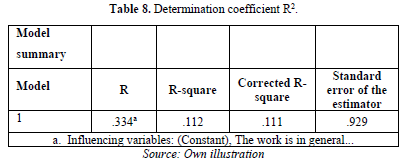
Table 8 shows that the sector (pharmacy or other pharmaceutical sector) has no significant influence (p=0.562 > 0.05). There are therefore no differences between the two cohorts in terms of hypothesis 3.
In summary, it can be concluded that hypothesis 3 has been confirmed. Whether the employees work in a pharmacy or in a different sector does not play a role. With regard to hypothesis 1, the following conclusions can be drawn from the regression analysis. The determining factor is the significance (p=) with a value of below 0.05, which is rated as a significant positive influence on job satisfaction. The skill variety in the job has a positive significant influence on job satisfaction: b=0.125, p < 0.01. It is thus deemed a relevant factor. The factor ‘interesting, varied work’ has no significant influence on job satisfaction: b=0.040, p=0.095 > 0.05. This means that this factor has no relevance in relation to job satisfaction. Autonomy, on the other hand, has a positive significant influence on job satisfaction: b=0.103, p < 0.01. Autonomy is therefore also a relevant factor. Feedback from supervisors and customers has a positive significant influence on job satisfaction: b=0.247 and b=0.145, p < 0.01 in both cases. This means that it is also to be considered a relevant factor for job satisfaction. This also applies to pay (B) with a positive significant influence on job satisfaction: b=0.178, p < 0.01. Once again, the factor is to be identified as an influencing determinant for job satisfaction. The difference between public and non-public pharmacies in relation to the hypotheses can be identified by integrating an additional dichotomous predictor into the regression analysis which maps distribution among the two sectors. The results of the analysis show that this predictor has no significant influence (p=0.921 > 0.05). There are therefore no differences between the two cohorts in terms of hypothesis 1. It can therefore be stated that hypothesis 1 overall and all its partial hypotheses have been confirmed at a rate of 4 to 5. For hypothesis 2, the findings can be summarised as follows. Perceived job satisfaction has a significant positive influence on motivation: b=0.235, p < 0.01. Equally, management has a significant positive influence on motivation: b=0.140, p < 0.01. Accordingly, both factors, job satisfaction and management, can be stated to be relevant for motivation. Comparing the two cohorts directly reveals that this parameter plays a significant role in hypothesis 2: p=0.034 < 0.05. As the coefficient (b=-0,184) of the regression is negative, it can be stated that the dependent variable of motivation is lower for non-public pharmacists for determining the validity of the hypothesis than for the public pharmacists. This means that motivation correlates more strongly with job satisfaction and management among the pharmacists in public pharmacies. Nevertheless, hypothesis 2 as a whole is thus confirmed. For hypothesis 3, a bivariate analysis of the regression is the decisive factor, with the results able to show that job satisfaction has a significant negative influence on turnover: b=0.235, p < 0.01. The following conclusion can therefore be drawn: Greater job satisfaction results in lower turnover in the form of switching to other professions. According to the findings, this applies equally in relation to the two cohorts, as p=0.562 > 0.05. There are therefore no differences between the two cohorts of pharmacists in terms of hypothesis 3. Hypothesis 3 is thus also statistically confirmed and all necessary proof has been provided to verify the claims, with the exception of the partial hypothesis ‘work that is more interesting and varied will lead to greater job satisfaction’.
DISCUSSION
The reasons for the poor development on the labour market in the public pharmacy sector can be found in various factors. This study focused on registered pharmacists with the status of employees. The results of this study have shown that the currently employed pharmacists are very satisfied with most aspects of their job. It follows that extrinsic motivation factors apply and that they also promote intrinsic motivation. This corresponds to the idea of pharmacists working in a helping profession and thus having a high level of intrinsic motivation [11]. The insight gained from the results has the following consequences. The existing personnel are predominantly satisfied with the work they do and derive motivation from this job satisfaction. In comparison, job satisfaction displays greater positive tendencies than other professional sectors in almost all areas. There is greater intrinsic and extrinsic motivation, which shows that pharmacists in public pharmacies seek out and perform this profession targetedly. This lends weight to the fundamental assumption that these people practise the job as a helping profession, as they predominantly perceive this to be important. In the assessment from the societal perspective, the percentage is once again higher than for the comparison group (43% positive versus 33.2%) and in the rating of the profession as a whole it is low compared with the comparative cohort (91.7% versus 87.1% with a positive trend). It can be seen, however, that young people with a qualification as a pharmacist hardly consider public pharmacies at all when choosing a profession. It is therefore important to identify the reasons why the younger generations do not perceive being a pharmacist as an attractive profession. The two relevant generations are Generation Y (born 1987-2000) and Generation Z (born 1997-2012). The expectations that Generation Y have for work and employers have been identified by Hartmann and Kibbat [12,13], among others:
For Generation Z, Scholz/Hartwig see the situation regarding the value system to be very different from that of other generations.
Both Generations Y and Z want to be involved in decisions which affect their work. Pharmacies generally have a small workforce and teams in the form of departments are rare. Furthermore, pharmacies are proprietor-operated companies and the proprietor makes almost all the decisions. The proprietor decides on the level of codetermination and involvement. This clashes with the young applicants’ expectations of involvement [15]. Other company forms have different options when they work in difference departments and working groups. They are referred to as agile companies, with flat hierarchies [16]. The results of this paper’s research reveals very positive tendencies for both cohorts with regard to development opportunities, with those currently employed in public pharmacies being aware of these opportunities (82.9% positive public pharmacist; 80.8% non-public pharmacist). The results for the public pharmacists are even clearer in relation to responsibility. This is because registered pharmacists are employed by the proprietors as pharmaceutical managers/co-decision-makers who stand in for the proprietor when they are absent.
In terms of work-life balance, one factor is apparent: in direct comparison, pharmacists in public pharmacies are less satisfied than their counterparts in other professional areas with the same qualifications. For future generations, it can be said that the ability to reconcile family and work is considered very important. The line between private life and work life is blurred. The most important thing is, however, that work be enjoyable and the outcome be acceptable both in terms of how it is perceived by the pharmacist and in financial terms [17]. Static and stationary work being no longer desirable (more working from home) and work-life balance are important factors in the rejection of work structures in public pharmacies. For the pharmacist, work cannot be performed from any other place apart from the public pharmacy. The working hours are also fixed. Depending on where the pharmacy is located, for example in a shopping centre, the opening hours are contractually bound to those of the shopping centre, and can extend to 8 p.m. In addition, pharmacies regularly have to be on emergency duty all night or on bank holidays.
CONCLUSION
As demand cannot be covered by nationally trained pharmacists, an important approach is the migration of fully trained specialists from other nations. The state needs to adjust the regulations to facilitate the recognition of qualifications and enable rapid integration into the profession. Qualifications are only recognised directly in the case of employees from other EU member states and associated states (Iceland, Switzerland, Liechtenstein and Norway), although many of these countries are experiencing the same shortage of specialists in the pharmacist sector. If personnel is recruited from other countries, the pharmacies should be committed to paying for language courses, which would means 5,000 euros per person on average for a language level of B2 and C1 as extension [18]. Furthermore, to be a fully recognised registered pharmacist in Germany, pharmacists must pass the third state exam, which is an additional hurdle for pharmacists coming from outside Germany. Another approach would be to relax the regulations for becoming registered to practice as a pharmacist, which would allow people with good qualifications to work in pharmacies. This could include graduates in chemistry, biology and combined subjects involving both fields, as well as medical graduates. The article can be a good basis for future research in aspects of job satisfaction. This approach would allow people to change careers and join the pharmacy profession in subareas of the core pharmacist competencies.
No Files Found
Share Your Publication :